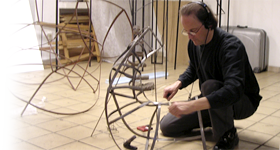Press
Selected Press Excerpts Music of Martin Herman
Ring Zone:
“...fascinating...a dazzling piece, intricate yet fragile”. “Los Angeles Times”, review by Josef Woodard (L.A. Times “Calendar” section) October 15, 1999.
The Fractal Bow:
“...the world premiere of Martin Herman’s engaging “The Fractal Bow”, a work employing algorithms to express the deeply resonating beauty and dynamism in chaos in musical terms. Yet the formidable math behind the composition results in a thoroughly interesting soundscape, a chugging, shifting, phasing-in-and-out type of music that shows the good sense of keeping its materials simple even while its processes are not. The orchestra gave it an energetic send-off.” “Los Angeles Times”, review by Timothy Mangan
“The first standing ovation went to a new work, Martin Herman’s “The Fractal Bow” ... “The Fractal Bow” turned out to be a dazzling whirl of color and pattern with emotionally gripping elements to boot. Whatever the computer contributed in the way of geometric patterns, Herman’s contribution was obviously the major thing that made the work successful. His contribution was not only in the choice of the material supplied by the computer but in the application to it of a brilliant orchestral imagination. Balter [the conductor] had the difficult piece well in hand, and he and the orchestra played it with as much affection as if it were an old friend.” “Long Beach Press Telegram”, review by David Levinson
Orlando:
“Herman’s Orlando employs snappy Minimalist music [in a] Post-modern take on Virginia Woolf’s novel... There is pleasure to be had in a visit to the laboratory [of experimental opera]”. “Los Angeles Times”, review by Mark Swed
“Herman’s music treats [Orlando] with both seriousness and humor. Orlando is sung with sheer liquid gold... The story plays out in lilting musicality full of rich vocal moments... The finale, where the two Orlandos sing to each other across a dressing table and through an imaginary mirror was an effective apotheosis. History will tell whether Downtown Opera takes off or crashes. But these two works, brief, effective, and entertaining, suggest there is plenty to look forward to. “Long Beach Press Telegram”, review by John Farrell
“Herman’s Orlando presented the art as schadeuwspiel, staged with real psychological insight. There was anticipation to be heard in its opening bars, the score being in turn driving and idyllic, with fascinating stutters. In short it was Long Beach Opera as we have come to know and love it, offering us what no other operatic company can or will.” “Beverly Hills Outlook”, review by Charles Lonberger
The Scarlet Letter:
“Berkeley, an improbable mother of opera makers, is still at it. Its fledgling company, Berkeley Contemporary Opera, gave a preview of Martin Herman’s “The Scarlet Letter” Saturday... Whether talents such as Berkeley-launched opera conductors as Christopher Keene, Kent Nagano, and Jonathan Khuner will emerge from this company cannot be predicted, but there is promise in composer Martin Herman and possibly for “The Scarlet Letter”... The work has substance, thought, and gratefully includes none of the slick tricks found in too many new operas. The essentials of Hawthorne’s classic novel were made eminently singable in Tom Curley’s well-written libretto, and Martin Herman’s music took full advantage. His music sings well in set piece arias, duos, and excellent choruses of the 17th century townsfolk. His music is involving and expressive. The musical line is strong in profile, the melodies have character, are well supported and kept out front. Herman’s style is linear and tonal in a rich and consistent harmonic idiom. There is always energy and a feeling of purpose and direction. The major arias sound as though they might really command the moment operatically. Most important are those for Hester Prynne... Her solos establish the inner strength around which Hawthorne’s story turns. “This badge of shame is now my pride” she sings. Next comes the minister, Arthur Dimmesdale, her secret lover, whose weakness and conflict make the first leg of the triangle of tension, the second being the vengeance and cruelty of Hester’s husband, Master Prynne... The orchestra’s music... is expressive, making significant active commentary even under these trial run circumstances.” “The San Francisco Chronicle”, review by Robert Commandy
“When it comes to daring operatic ventures in the Southland, it seems that all roads lead to Long Beach... The operatic muse was in town again Thursday night as Martin Herman’s “The Scarlet Letter” [was performed] in the Carpenter Center... the performance left a strong clear impression. Herman’s musical language works well... giving the work a bold and post-modern character...” “The Los Angeles Times”, review by Josef Woodard
Hawthorne Symphony:
“Martin Herman’s “Hawthorne Symphony”, taken from the composer’s opera-in-progress, is highly dramatic. Its shape is linear, as if unfolding a story; its texture is thick, roiling and even broiling in parts. One looks forward to hearing the full opera.” “New York Post”, review by Susan Elliott, April 20, 1989
“A Distinction at Carnegie: Concert World Premieres. The Carnegie Hall concert on Tuesday evening by the recently organized New Music Orchestral Project claimed at least one distinction: never before, apparently, had an entire program of world premieres been presented in that hallowed place. Rehearsing and performing such an ambitious night of music would strain the resources of any orchestra, but Jorge Mester, artistic director of the ensemble, brought off the four complicated new works without a major hitch... The “Hawthorne” Symphony of Martin Herman, consisting of three episodes drawn from an opera in progress, “The Scarlet Letter,” adopted in its first and last movements a texture that... emerged as a kind of Whistler study in various shades of gray.” “New York Times”, review by Donal Henahan
“Another grandly scaled piece was Martin Herman’s “Hawthorne Symphony”, music of long, sprawling lines with huge percussion punctuation and as dramatic as anything Puccini wrote. The verismo effect was reinforced by the knowledge that the musical materials have been taken from Herman’s opera in progress, based on Nathaniel Hawthorne’s “The Scarlet Letter”. “San Francisco Chronicle”, review by Marilyn Tucker






